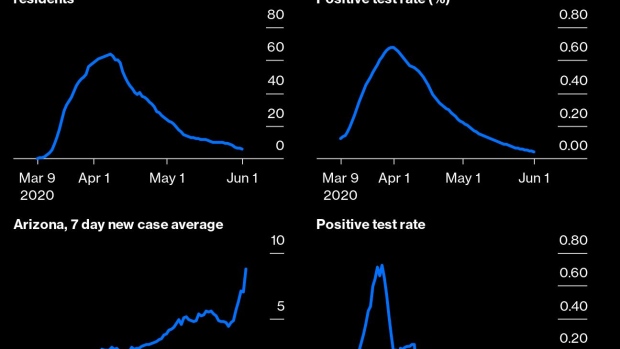Jun 8, 2020
New York City’s Reopening Rides on Subways and Elevators
, Bloomberg News

(Bloomberg Opinion) -- New York City's limited reopening Monday from Covid-19 lockdowns won't dramatically affect all of its residents. Still, it's a big first step for one of the world's hardest-hit regions and a hard-won accomplishment.
The population-adjusted new case rate in the city has steadily declined even with expansive testing to the point where New York is beating more than a dozen states, putting it firmly on the other side of America's worst outbreak. Wednesday was its first day in months without a recorded Covid-related death. Like the rest of the world, however, the city’s fight against the coronavirus is far from over. New York's 1,000 plus cases in the last seven days are nothing compared to April, but they still represent many potential outbreaks. The next few months of choices will determine whether the city's progress continues.
New York is starting in the right place. Its reopening is slow and dependent on a variety of metrics that other regions have ignored. The first phase allows a restart for manufacturing, construction, and wholesale businesses, as well as a limited resumption of retail sales. Even its second planned phase in July, which would allow outdoor dining and more offices to open, is substantially less aggressive than what some states did as soon as April. The challenge lies in remaining vigilant with each step the city takes toward returning to normal so cases stay low for the long haul.
The reopening problems New York faces aren't unique. Other cities also have to figure out how to protect passengers using mass transit, ensure safety is maintained getting in and out of office buildings and make plans for the new school year. The difference is scale. The Metropolitan Transportation Authority carries far more people than other U.S. transit systems, while the New York City public-school system’s one-million-plus student body dwarfs that of anywhere else in the nation, surpassing No. 2 Los Angeles Unified by more than 400,000 pupils. And the schools operate in tighter spaces.
The Centers for Disease Control and Prevention continue to produce reopening guidance. It's not always helpful for New York. The agency, for example, recommends that workers avoid using public transit to get to work. That isn't an option for most of the city's workforce. New York will have to find solutions on its own.
There's been lots of pondering but few decisions made on how to keep subways safe when thousands head back to work on Monday, and there’s been little in the way of public guidance on the far greater challenge of maintaining distancing when millions more join. It ought to be a priority, given the tendency of the virus to spread in crowded, poorly ventilated spaces. Nightly cleanings are only a start.
The transit agency’s constantly overburdened budget has also been badly stressed by plunging ridership. Early comments from Mayor Bill de Blasio and New York Governor Andrew Cuomo suggest that they'll be relying on commuters in many cases to avoid crowded trains and buses, advice that is often incompatible with getting anywhere on time. The state requires masks in crowded places, and the MTA plans to hand them out to riders who lack them, at least from June 8 to June 12. The state has taken a light touch with face-covering enforcement throughout the crisis, and having enough staff and masks on hand as reopening expands will be challenging.
Suggested symptom checks in office buildings are time-consuming theater. While limiting elevator capacity to 50% may be a prudent recommendation, getting to a desk every day will be an ordeal. It will get old fast, and compliance is likely to fade as more people return to work. The decision on how and when schools will reopen won't come until July and may be accompanied by enormous budget cuts that will undermine safety efforts.
On the positive side, New York is investing in significant contact tracing efforts, which should help catch cases and guide policy going forward. However, the city is still some ways from doing case-based interventions on a massive scale.
These efforts will be complicated should recent protests over race and police treatment persist. Crowds and tightly packed marches could lead to more cases and will be a challenge for tracers. And as with all other public health efforts, tracing relies on participation from New York's citizens. Trust isn't guaranteed at a time of increased civic tensions; authorities’ response, outreach and ability to win cooperation from the public will be key to early detection and containment of any future outbreaks.
It will only get harder to rein back activity once people taste freedom. Failing to do so or losing the buy-in needed to respond to a spike could be tragic. The city and state need to communicate thresholds for renewed restrictions and figure out a strategy for possible targeted shutdowns.
New York may have a larger margin of error than it did in the spring, given the comparatively high degree of acquired immunity in a population that is fully aware of how bad things can get. Even so, it’s important to note that the majority of New Yorkers are still potentially at risk. The peculiarities that made it an outlier haven't vanished, and should be top of mind for inhabitants and leaders going forward.
This column does not necessarily reflect the opinion of the editorial board or Bloomberg LP and its owners.
Max Nisen is a Bloomberg Opinion columnist covering biotech, pharma and health care. He previously wrote about management and corporate strategy for Quartz and Business Insider.
©2020 Bloomberg L.P.